Chapter 10 Circles
10.1 Introduction
You have studied in Class IX that a circle is a collection of all points in a plane which are at a constant distance (radius) from a fixed point (centre). You have also studied various terms related to a circle like chord, segment, sector, arc etc. Let us now examine the different situations that can arise when a circle and a line are given in a plane.
So, let us consider a circle and a line PQ. There can be three possibilities given in Fig. 10.1 below:

Fig. 10.1
In Fig. 10.1 (i), the line PQ and the circle have no common point. In this case, PQ is called a non-intersecting line with respect to the circle. In Fig. 10.1 (ii), there are two common points
You might have seen a pulley fitted over a well which is used in taking out water from the well. Look at Fig. 10.2. Here the rope on both sides of the pulley, if considered as a ray, is like a tangent to the circle representing the pulley.

Fig. 10.2
Is there any position of the line with respect to the circle other than the types given above? You can see that there cannot be any other type of position of the line with respect to the circle. In this chapter, we will study about the existence of the tangents to a circle and also study some of their properties.
10.2 Tangent to a Circle
In the previous section, you have seen that a tangent[^0] to a circle is a line that intersects the circle at only one point.
To understand the existence of the tangent to a circle at a point, let us perform the following activities:
Activity 1 : Take a circular wire and attach a straight wire
at a point of the circular wire so that it can rotate about the point in a plane. Put the system on a table and gently rotate the wire about the point to get different positions of the straight wire [see Fig. 10.3(i)].
In various positions, the wire intersects the circular wire at

Fig. 10.3 (i)
While doing activity above, you must have observed that as the position
The tangent to a circle is a special case of the secant, when the two end points of its corresponding chord coincide.
Activity 2 : On a paper, draw a circle and a secant PQ of the circle. Draw various lines parallel to the secant on both sides of it. You will find that after some steps, the length of the chord cut by the lines will gradually decrease, i.e., the two points of intersection of the line and the circle are coming closer and closer [see Fig. 10.3(ii)]. In one case, it becomes zero on one side of the secant and in another case, it becomes zero on the other side of the secant. See the positions
and of the secant in Fig. 10.3 (ii). These are the tangents to the circle parallel to the given secant PQ. This also helps you to see that there cannot be more than two tangents parallel to a given secant.

Fig. 10.3 (ii)
This activity also establishes, what you must have observed, while doing Activity 1, namely, a tangent is the secant when both of the end points of the corresponding chord coincide.
The common point of the tangent and the circle is called the point of contact [the point A in Fig. 10.1 (iii)]and the tangent is said to touch the circle at the common point.
Now look around you. Have you seen a bicycle or a cart moving? Look at its wheels. All the spokes of a wheel are along its radii. Now note the position of the wheel with respect to its movement on the ground. Do you see any tangent anywhere? (See Fig. 10.4). In fact, the wheel moves along a line which is a tangent to the circle representing the wheel. Also, notice that in all positions, the radius through the point of contact with the ground appears to be at right angles to the tangent (see Fig. 10.4). We shall now prove this property of the tangent.

Fig. 10.4
Theorem 10.1 : The tangent at any point of a circle is perpendicular to the radius through the point of contact.
Proof : We are given a circle with centre
Take a point
The point
Since this happens for every point on the line

Fig. 10.5
Remarks
1. By theorem above, we can also conclude that at any point on a circle there can be one and only one tangent.
2. The line containing the radius through the point of contact is also sometimes called the ’normal’ to the circle at the point.
EXERCISE 10.1
1. How many tangents can a circle have?
Show Answer
Solution
A circle can have infinite tangents.
2. Fill in the blanks :
(i) A tangent to a circle intersects it in _______ point (s).
(ii) A line intersecting a circle in two points is called a _______.
(iii) A circle can have _______ parallel tangents at the most.
(iv) The common point of a tangent to a circle and the circle is called _______.
Show Answer
Solution
(i) One
(ii) Secant
(iii) Two
(iv) Point of contact
3. A tangent
(A)
(B)
(C)
(D)
Show Answer
Solution
We know that the line drawn from the centre of the circle to the tangent is perpendicular to the tangent.
By applying Pythagoras theorem in

Hence, the correct answer is (D).
4. Draw a circle and two lines parallel to a given line such that one is a tangent and the other, a secant to the circle.
Show Answer
Solution

It can be observed that
10.3 Number of Tangents from a Point on a Circle
To get an idea of the number of tangents from a point on a circle, let us perform the following activity:
Activity 3 : Draw a circle on a paper. Take a point
inside it. Can you draw a tangent to the circle through this point? You will find that all the lines through this point intersect the circle in two points. So, it is not possible to draw any tangent to a circle through a point inside it [see Fig. 10.6 (i)].
Next take a point
Finally, take a point

Fig. 10.6
We can summarise these facts as follows:
Case 1 : There is no tangent to a circle passing through a point lying on the circle.
Case 2 : There is one and only one tangent to a circle passing through a point lying on the circle.
Case 3 : There are exactly two tangents to a circle through a point lying outside the circle.
In Fig. 10.6 (iii),
The length of the segment of the tangent from the external point
Note that in Fig. 10.6 (iii),
Theorem 10.2: The lengths of tangents drawn from an external point to a circle are equal.
Proof: We are given a circle with centre

Fig. 10.7
For this, we join OP, OQ and OR. Then
OQ
OP
Therefore,
This gives
Remarks
1. The theorem can also be proved by using the Pythagoras Theorem as follows:
which gives
2. Note also that
Let us take some examples.
Example 1 : Prove that in two concentric circles, the chord of the larger circle, which touches the smaller circle, is bisected at the point of contact.
Solution : We are given two concentric circles

Fig. 10.8
Let us join OP. Then,
Now
i.e.,
Example 2 : Two tangents
Solution : We are given a circle with centre

Fig. 10.9
Let
Now, by Theorem 10.2, TP = TQ. So, TPQ is an isosceles triangle.
Therefore,
Also, by Theorem 10.1,
So,
This gives
Example 3 : PQ is a chord of length
Solution : Join OT. Let it intersect PQ at the point

Fig. 10.10
Also,
Now,
So,
Therefore, right triangle TRP is similar to the right triangle PRO by AA similarity.
This gives
Note : TP can also be found by using the Pythagoras Theorem, as follows:
Let
Subtracting (1) from (2), we get
Therefore,
EXERCISE 10.2
In Q. 1 to 3, choose the correct option and give justification.
1. From a point
(A)
(B)
(C)
(D)
Show Answer
Solution
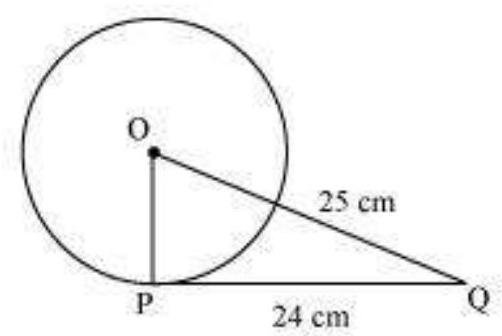
Let
Given that,
As the radius is perpendicular to the tangent at the point of contact,
Therefore,
Applying Pythagoras theorem in
Therefore, the radius of the circle is
Hence, alternative (A) is correct.
2. In Fig. 10.11, if
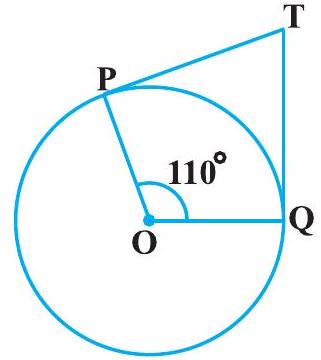
Fig. 10.11
(A)
(B)
(C)
(D)
Show Answer
Solution
It is given that TP and TQ are tangents.
Therefore, radius drawn to these tangents will be perpendicular to the tangents.
Thus,
In quadrilateral POQT,
Sum of all interior angles
Hence, alternative (B) is correct.
3. If tangents
(A)
(B)
(C)
(D)
Show Answer
Solution
It is given that PA and PB are tangents.
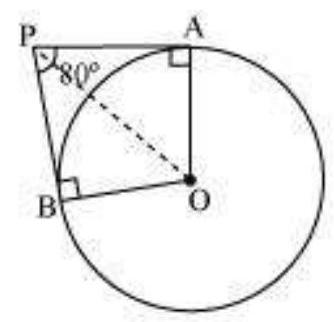
Therefore, the radius drawn to these tangents will be perpendicular to the tangents.
Thus,
In AOBP,
Sum of all interior angles
In
Therefore,
And thus,
Hence, alternative (A) is correct.
4. Prove that the tangents drawn at the ends of a diameter of a circle are parallel.
Show Answer
Solution
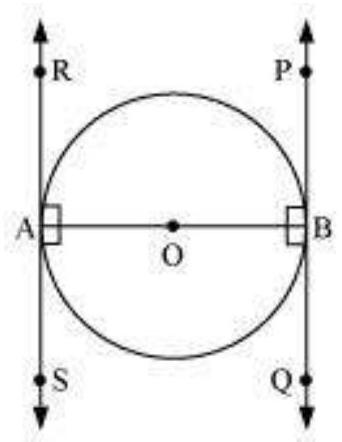
Let
Thus,
It can be observed that
Since alternate interior angles are equal, lines
5. Prove that the perpendicular at the point of contact to the tangent to a circle passes through the centre.
Show Answer
Solution
Let us consider a circle with centre

We have to prove that the line perpendicular to
Let us assume that the perpendicular to
As perpendicular to
Comparing equations (1) and (2), we obtain
From the figure, it can be observed that,
Therefore,
Therefore, the perpendicular to
6. The length of a tangent from a point
Show Answer
Solution
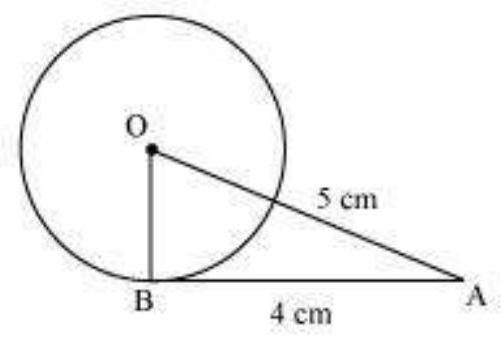
Let us consider a circle centered at point
Given that,
In
Applying Pythagoras theorem in
Hence, the radius of the circle is
7. Two concentric circles are of radii
Show Answer
Solution
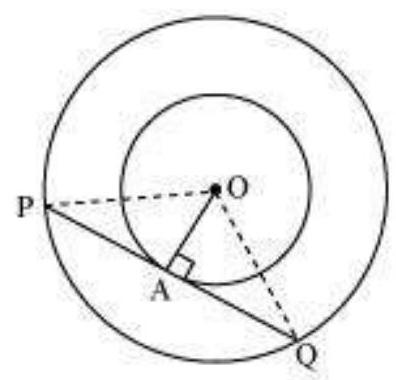
Let the two concentric circles be centered at point
Applying Pythagoras theorem in
In
Since
Therefore, the length of the chord of the larger circle is
8. A quadrilateral
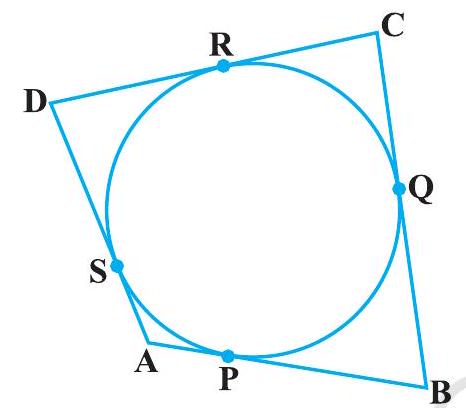
Fig. 10.12
Show Answer
Solution
It can be observed that
DR
AP
Adding all these equations, we obtain
9. In Fig. 10.13,

Fig. 10.13
Show Answer
Solution
Let us join point

In
Therefore,
Similarly,
Since POQ is a diameter of the circle, it is a straight line.
Therefore,
From equations (i) and (ii), it can be observed that
10. Prove that the angle between the two tangents drawn from an external point to a circle is supplementary to the angle subtended by the line-segment joining the points of contact at the centre.
Show Answer
Solution
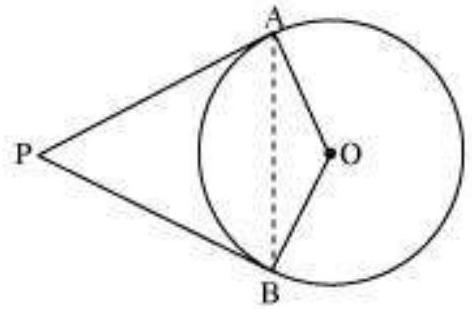
Let us consider a circle centered at point
It can be observed that
Therefore,
Similarly, OB (radius)
In quadrilateral OAPB,
Sum of all interior angles
Hence, it can be observed that the angle between the two tangents drawn from an external point to a circle is supplementary to the angle subtended by the line-segment joining the points of contact at the centre.
11. Prove that the parallelogram circumscribing a circle is a rhombus.
Show Answer
Solution
Since
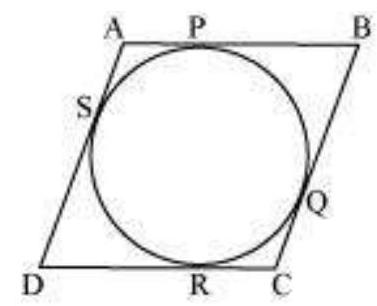
It can be observed that
DR
AP = AS (Tangents on the circle from point A)
Adding all these equations, we obtain
On putting the values of equations (1) and (2) in this equation, we obtain
Comparing equations (1), (2), and (3), we obtain
Hence,
12. A triangle
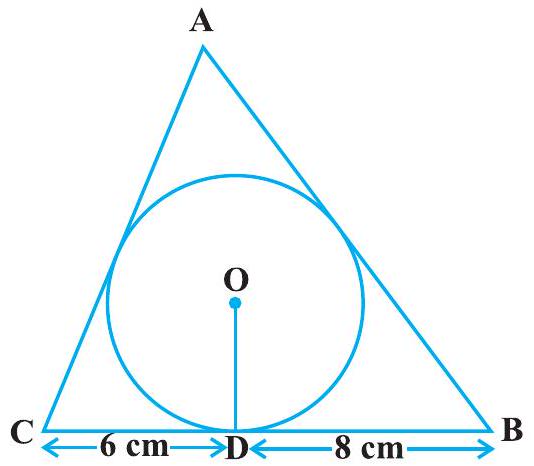
Fig. 10.14
Show Answer
Solution
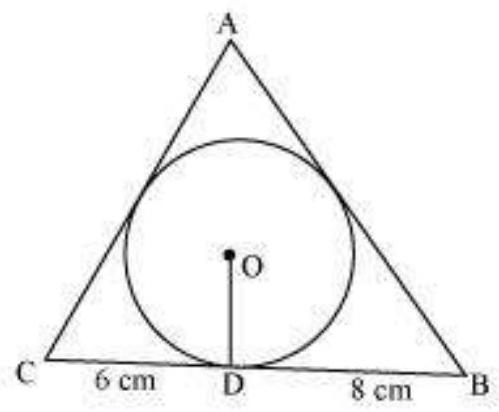
Let the given circle touch the sides
In
Area of
Area of
Area of
Area of
Either
Therefore,
However,
Therefore,
Hence,
13. Prove that opposite sides of a quadrilateral circumscribing a circle subtend supplementary angles at the centre of the circle.
Show Answer
Solution
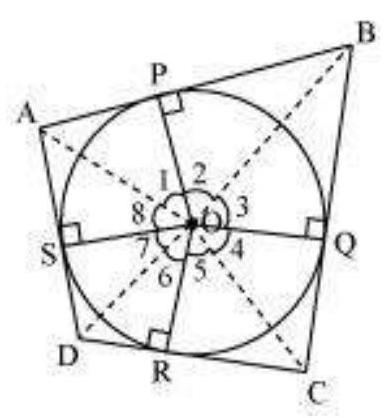
Let
Consider
AP
And thus,
Similarly,
Similarly, we can prove that
Hence, opposite sides of a quadrilateral circumscribing a circle subtend supplementary angles at the centre of the circle.
10.4 Summary
In this chapter, you have studied the following points :
1. The meaning of a tangent to a circle.
2. The tangent to a circle is perpendicular to the radius through the point of contact.
3. The lengths of the two tangents from an external point to a circle are equal.










